Known for Use of sign language | ||
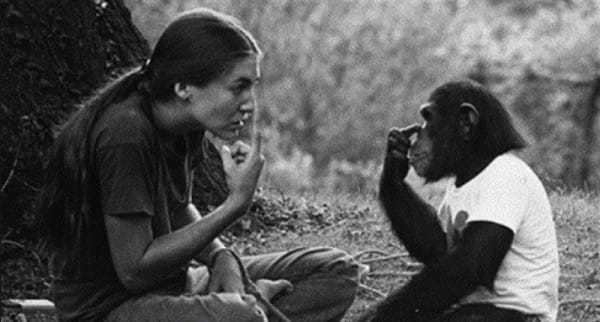 | ||
Died October 30, 2007 (aged 42)Central Washington University | ||
Washoe (c. September 1965 – October 30, 2007) was a female common chimpanzee who was the first non-human to learn to communicate using American Sign Language as part of a research experiment on animal language acquisition.
Contents
- Early life
- Teaching method
- Confirmed Signs
- Combinations of signs
- Self awareness and emotion
- Later life and death
- Impact on bioethics
- Related animal language projects
- Quotes
- References
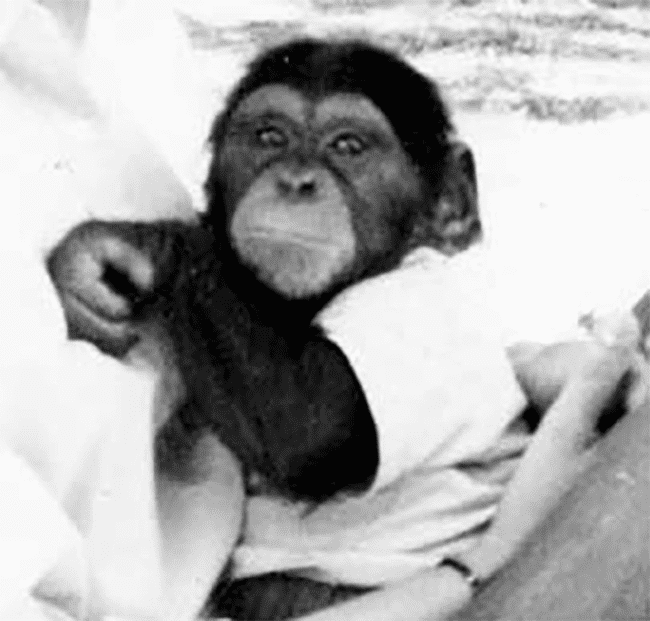
Washoe learned approximately 350 signs of ASL. She also taught her adopted son Loulis some signs.
Early life
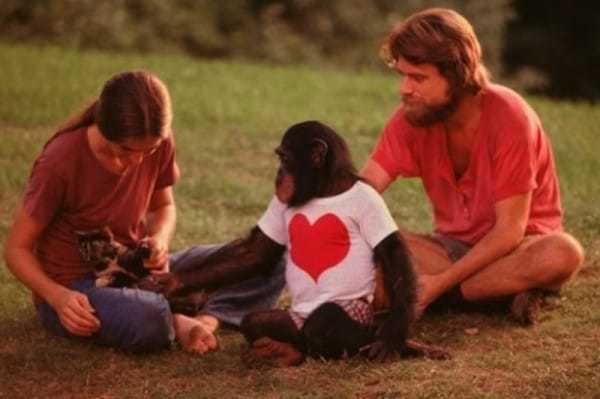
Washoe was born in West Africa in 1965. She was captured for use by the US Air Force for research for the space program. Washoe was named after Washoe County, Nevada, where she was raised and taught to use ASL.

In 1967, Allen and Beatrix Gardner established a project to teach Washoe ASL at the University of Nevada, Reno. At the time, previous attempts to teach chimpanzees to imitate vocal languages (the Gua and Vicki projects) had failed. The Gardners believed that these projects were flawed because chimps are physically unable to produce the voiced sounds required for oral language. Their solution was to utilize the chimpanzee's ability to create diverse body gestures, which is how they communicate in the wild, by starting a language project based on American Sign Language. The Gardners raised Washoe as one would raise a child. She frequently wore clothes and sat with them at the dinner table. Washoe had her own 8 x 24 foot trailer complete with living and cooking areas. The trailer had a couch, drawers, a refrigerator, and a bed with sheets and blankets. She had access to clothing, combs, toys, books, and a toothbrush. Much like a human child, she underwent a regular routine with chores, outdoor play, and rides in the family car. One claim was that upon seeing a swan, Washoe signed "water" and "bird". Harvard psychologist Roger Brown said that "was like getting an S.O.S. from outer space".

When Washoe was five, the Gardners decided to move on to other projects, and she was moved to the University of Oklahoma's Institute of Primate Studies in Norman, Oklahoma, under the care of the Foutses.
Teaching method
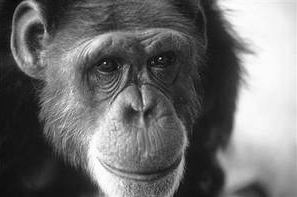
Washoe was raised in an environment as close as possible to that of a human child, in an attempt to satisfy her psychological need for companionship.
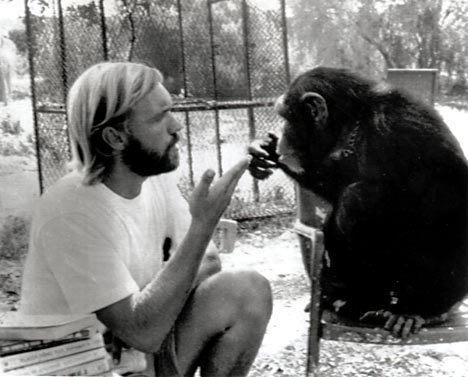
While with Washoe, the Gardners and Fouts were careful to communicate only in ASL with Washoe, rather than using vocal communication, on the assumption that this would create a less confusing learning environment for Washoe. This technique is commonly used when teaching human children how to sign.
After the first couple of years of the language project, the Gardners and Roger Fouts discovered that Washoe could pick up ASL gestures without direct instruction, but instead by observing humans around her who were signing amongst themselves. For example, the scientists signed "Toothbrush" to each other while they brushed their teeth near her. At the time of observation, Washoe showed no signs of having learned the sign, but on a later occasion she reacted to the sight of a toothbrush by spontaneously producing the correct sign, thereby showing that she had in fact previously learned the ASL sign. Moreover, the Gardners began to realize that rewarding particular signs with food and tickles was actually interfering with the intended result of conversational sign language. They changed their strategy so that food and meal times were never juxtaposed with instruction times. In addition, they stopped the tickle rewards during instruction because these generally resulted in laughing breakdowns. Instead, they set up a conversational environment that evoked communication, without the use of rewards for specific actions.
Confirmed Signs
Washoe learned approximately 350 words of sign languages.
For researchers to consider that Washoe had learned a sign, she had to use it spontaneously and appropriately for 14 consecutive days.
These signs were then further tested using a double-blind vocabulary test. This test demonstrated 1) "that the chimpanzee subjects could communicate information under conditions in which the only source of information available to a human observer was the signing of the chimpanzee;" 2) "that independent observers agreed with each other;" and 3) "that the chimpanzees used the signs to refer to natural language categories - that the sign DOG could refer to any dog, FLOWER to any flower, SHOE to any shoe."
Combinations of signs
Washoe and her mates were able to combine the hundreds of signs that they learned into novel combinations (that they had never been taught, but rather created themselves) with different meanings. For instance, when Washoe's mate Moja didn't know the word for "thermos", Moja referred to it as a "METAL CUP DRINK". However, whether or not Washoe's combinations constitute genuine inventive language is controversial, as Herbert S. Terrace contended by concluding that seeming sign combinations did not stand for a single item, but rather were three individual signs. Taking the thermos example, rather than METAL CUP DRINK being a composite meaning thermos, it could be that Washoe was indicating there was an item of metal (METAL), one shaped like a cup (CUP), and that could be drunk out of (DRINK).
Self-awareness and emotion
One of Washoe's caretakers was pregnant and missed work for many weeks after she miscarried. Roger Fouts recounts the following situation:
People who should be there for her and aren't are often given the cold shoulder--her way of informing them that she's miffed at them. Washoe greeted Kat [the caretaker] in just this way when she finally returned to work with the chimps. Kat made her apologies to Washoe, then decided to tell her the truth, signing "MY BABY DIED". Washoe stared at her, then looked down. She finally peered into Kat's eyes again and carefully signed "CRY", touching her cheek and drawing her finger down the path a tear would make on a human (Chimpanzees don't shed tears). Kat later remarked that one sign told her more about Washoe and her mental capabilities than all her longer, grammatically perfect sentences.
Washoe herself lost two children: one baby died shortly after birth of a heart defect, the other baby, Sequoyah, died of a staph infection at two months of age.
When Washoe was shown an image of herself in the mirror, and asked what she was seeing, she replied: "Me, Washoe". Primate expert Jane Goodall, who has studied and lived with chimpanzees for decades, believes that this might indicate some level of self awareness. Washoe appeared to experience an identity crisis when she was first introduced to other chimpanzees, seeming shocked to learn that she was not human. She gradually came to enjoy associating with other chimps.
Washoe enjoyed playing pretend with her dolls, which she would bathe and talk to and would act out imaginary scenarios. She also spent time brushing her teeth, painting and taking tea parties.
When new students came to work with Washoe, she would slow down her rate of signing for novice speakers of sign language, which had a humbling effect on many of them.
Later life, and death
Washoe had lived at Central Washington University since 1980; on October 30, 2007, officials from the Chimpanzee and Human Communication Institute on the CWU campus announced that she had died at the age of 42.
Impact on bioethics
Some believe that the fact that Washoe not only communicated, but also formed close and personal relationships with humans indicates that she is emotionally sensitive and is deserving of moral status.
Work with Washoe and other signing primates motivated the foundation of the Great Ape Project, which hopes to "include the non-human great apes [chimpanzees, orangutans, and gorillas] within the community of equals by granting them the basic moral and legal protections that only humans currently enjoy", in order to place them in the moral category of "persons" rather than private property.
Related animal language projects
The Nim Chimpsky project failed in its attempt to replicate the results of Washoe. This failure is attributed to poor teaching, and to Nim being consistently isolated in a sterile laboratory environment, and often confined in cages, for his entire life. Nim did most of his learning in a white eight-by-eight laboratory room (with one of the walls containing a one-way mirror), where he was often trained to use signs without the referent present. Living in this setting, Nim did not receive the same level of nurturing, affection, and life experience, and many have suggested that this impaired his cognitive development, as happens with human children subjected to such an environment.
The publication of the Washoe experiments spurred a revival in the scholarly study of sign language, due to widespread interest in questions it raised about the biological roots of language.
Quotes
(In this section double quotes are signed by Washoe, single by someone else.)
